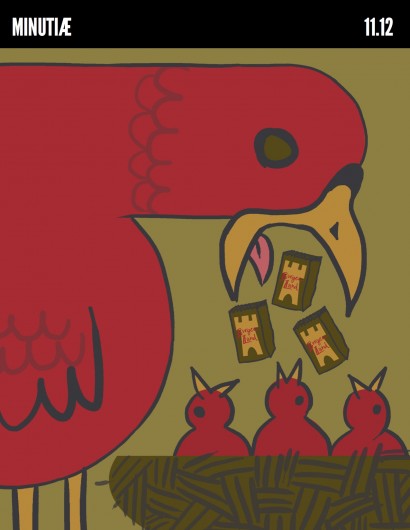Shell Shock
by Farley Elliott
Residents of Houston, Texas can sleep a little easier now, knowing that nearly 900 small and medium-sized arms are off of their city streets this month, thanks to the mayor’s yearly Guns For Gifts program. But for many of the volunteers and core staffers behind the gun giveback initiative, there are sure to be a few sleepless nights.
Lucinda Marshall, a longtime Houston resident and first year volunteer, has found herself tossing and turning in the nights since the gun giveback ended. “It’s terrifying,” she says, holding a steaming cup of coffee under her bleary eyes. “The public just sees the statistics and thinks ”˜well it’s good all those guns are gone’. But they don’t understand the process.” Mike Wahl, a former beat cop and three-year veteran of the incentive program, agrees. “Every single person I’ve talked to in the years I’ve been doing this has come away with great pride for making the streets safer, but even more anxiety. It’s tough even for me to come back, but at the end of the day I know that what I’m doing is right.”
On its surface, the simple mechanics of the gun giveback program seem fairly straightforward. Anyone within 30 miles of the downtown Houston Police Department headquarters — a range that includes the city limits of Houston proper and much of Harris County — is free to turn in their handguns, rifles, or small ordinance devices in exchange for a ticket. The paper tickets can then be exchanged for goods on the spot, including home electronics, books, canned goods, furniture and more. All of the items are either donated from local businesses or are the result of police seizure. The benefits for the city are three-fold: fewer guns on the streets, fewer cobra necklaces in the impound lockers and all of the positive press that comes with such a program.
Yet, for those running the gun giveback on the day of the event, it’s an unrelenting nightmare.
A mob of impatient Houstonians gather downtown well in advance of the 9am start time, jockeying for line position in order to secure the best exchange items. And, since the giveback policy is one ticket per gun, the heartiest morning folks are also the most well-armed, stuffed to the gills with hidden single-shot pistols, Marine-grade assault rifles, and even (in one instance) a Golden Gun. Tensions mount in the moments before the doors open to the public, leading to pushing and shoving despite many early-goers being strapped with ancient grenades and cocked shotguns.
As the doors open, a sea of armed and angry gun-wielders burst into the large hall, tripping over each other and inadvertently discharging their firearms in the process. From the volunteer table, the scene is something akin to the old world style of battle, where front line men in bundled coats were little more than bullet fodder. Except here, the bullets are indiscriminate, and the random shots are coming from the brigade itself. “We tell them, every year, to remove the bullets, but… ugh… they just don’t listen,” says Wahl.
Those fortunate to reach the tables unscathed immediately dump their loaded wares, spilling out cartridges and knocking off safeties with abandon as they scream for their precious exchange tickets. After all, the early prizes are certainly the most valuable. “Last year, somebody took home a horse,” says Wahl, the officer-turned-volunteer. “It used to belong to a cartel member who fancied himself a racing man, but when he got taken down the chief said ”˜what the hell are we going to do with a horse?,’ and sent it over to us.” Other ostentatious items have included hydraulically-enhanced cars used in smuggling rings, a Renoir painting that hung in the private home of a wealthy oil businessman before he was murdered by his wife, and a rare Super‑8 film of The Beatles doing improv comedy.
Wahl grimaces as he feels the phantom pains of a pinkie toe that was blown off two years ago at the gun giveback program. “I’d be lying if I said it wasn’t a bit like my time on the force, though”, he gleams as he rubs his foot. “It certainly gets the old juices flowing.” For others, the thrill has been replaced with memories they won’t soon forget.
Lucinda Marshall sighs over yet another cup of early morning joe. “I see them just at the moment I’m about to fall asleep. As the horizon line falls away in front of me, here they come, pushing, shoving their way towards me, some with more than two arms just so they can hold all of their guns.”
By the third hour, things are relatively calm at the giveback, as most of the best trade pieces have already been purloined, but you can never be too safe. Last year, just before the program shut down for the day, an octogenarian with a single-barrel shotgun entered, using the gun as a cane. Before ever reaching the table he stumbled and discharged one shell straight through the floor and into the men’s restroom below. Thankfully, only a Hispanic member of the janitorial staff was killed, and people were getting his name wrong all the time anyway.
Now, with the 2013 Houston Guns For Gifts already on the calendar for next fall, Marshall is unsure if she’ll return. Sure, there’s the satisfaction of taking guns off the streets and providing a service to her community, but the haunting images and blood-speckled ID badge don’t make the proposition very enticing. Still, she’s got eleven months to decide. Until then, she jumps whenever a car door slams too loudly, and will often leave a store if a crowd forms. For Marshall, Wahl and many others, it’s all an unintended consequence of a program that just keeps on giving. ♦
